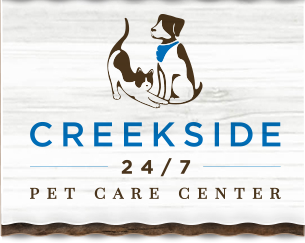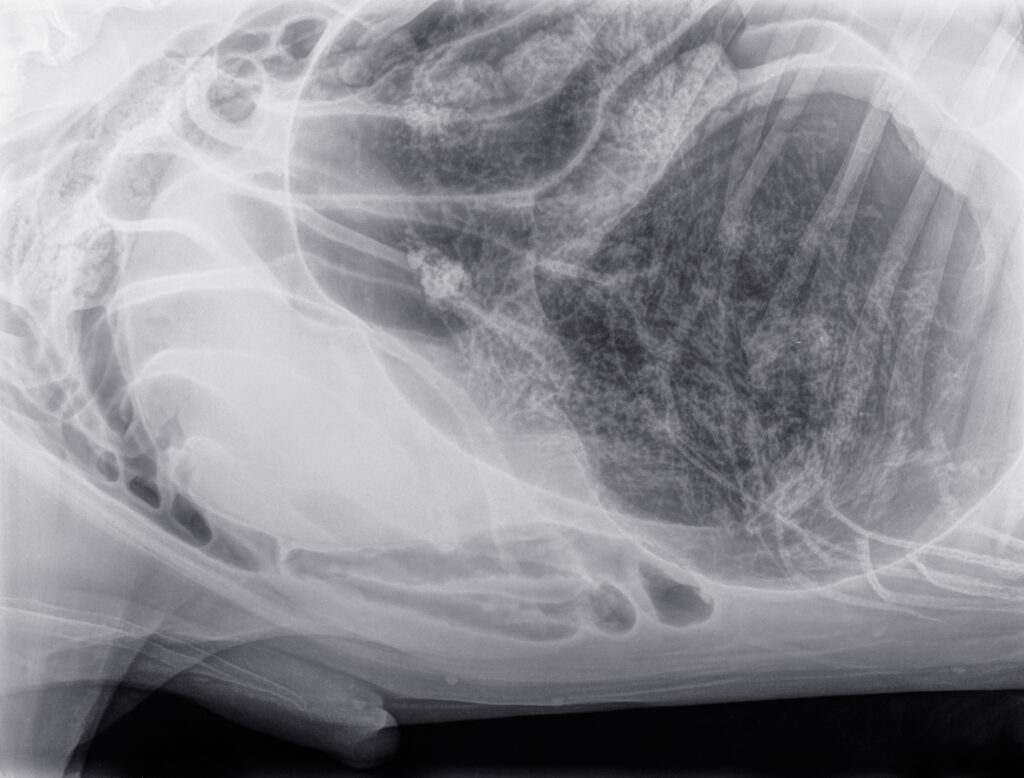Bloat, technically known as Gastric Dilatation-Volvulus (GDV), is a severe health concern that affects some dogs. Our goal here is to offer valuable insights into GDV, its causes, and its symptoms, so you’ll know what to look for in case your dog ever experiences this condition. At Creekside Pet Care Center in Keller, TX, we’re dedicated to providing pet owners with the knowledge they need to provide the best care to their companions. If you have any questions or need to schedule a visit, feel free to call us at (817) 421-5850.
What Exactly is Bloat in Dogs?
Bloat is a swift and life-threatening condition that begins when a dog’s stomach fills with gas and starts to expand. This is a serious problem because the expanded stomach can twist upon itself in a process known as volvulus.
When volvulus happens, both the entry and exit of the stomach are blocked, trapping the gas inside. This condition is extremely painful and causes the dog’s stomach to bloat, leading to a noticeable distension of the abdomen. The trapped gas and twisted stomach disrupt normal blood flow, not only to the stomach but potentially to other vital organs. The reduced blood circulation can rapidly lead to tissue death and, if untreated, can cause severe shock and even death.
Factors That Lead to Bloat in Dogs
While the exact cause of bloat can vary slightly from one dog to another, several factors are known to increase the risk:
- Physical Attributes: Large breeds with deep chests are particularly prone to bloat. The spacious abdominal cavity in these breeds can allow the stomach to move more freely, increasing the risk of twisting.
- Age and Health Conditions: Older dogs or those with a history of digestive disturbances are also at a heightened risk.
- Eating Habits: Dogs that eat rapidly, consume large meals in one sitting, or drink excessive amounts of water quickly after eating are at a higher risk of developing bloat. Fast eating can cause a rapid influx of gas and fluid into the stomach.
- Exercise Patterns: Vigorous activity either before or immediately after eating can contribute to the development of bloat.
- Temperament: Dogs that are more prone to stress or anxiety may have altered digestive processes that could predispose them to bloat.
When to Seek Help for Your Dog
Knowing the potential signs of bloat can save your pet’s life. Bloat progresses quickly and can be fatal in a matter of hours if it isn’t treated. If your dog has a swollen abdomen, is pacing restlessly, trying to vomit without bringing anything up, or showing signs of pain and distress, these are red flags and a likely sign of bloat.
Additionally, a rapid heartbeat, labored breathing, and pale gums are serious symptoms that require urgent attention. If you notice any of these signs, you need to get your dog to a veterinarian or an emergency animal hospital right away.
Treating Bloat in Dogs
Treating bloat typically involves several critical steps:
- Stabilization: The first step is to stabilize your dog, which may include administering fluids and providing pain relief.
- Decompression: The veterinarian will need to relieve the pressure in your pet’s stomach. This is often done by inserting a tube down the throat into the stomach to release gas and fluids. If this is not possible, a needle may be inserted into the stomach through the abdomen to relieve the pressure.
- Surgery: In most cases of bloat, surgery is necessary to correct the twist. The vet will untwist the stomach and then possibly attach it to the abdominal wall, a procedure known as gastropexy, to prevent future occurrences.
Post-Treatment Care for Your Dog
After treatment, your dog needs to be monitored closely and allowed plenty of rest. This means they might need to stay at the hospital for a couple of days to make sure their condition is stable and they are healing properly. Post-surgery, your vet will provide specific instructions on diet, activity level, and medication. Follow-up visits are important to ensure your dog’s recovery and monitor for any complications.
How to Reduce Your Dog’s Risk of Bloat
While bloat cannot always be prevented, there are measures you can take to reduce the risk for your pet:
- Dietary Management: Feed your pet smaller, more frequent meals and discourage rapid eating. Special bowls designed to slow down eating can be helpful.
- Controlled Exercise: Avoid vigorous exercise immediately before and after meals.
- Regular Health Checks: Keep up with regular veterinary checkups to monitor your pet’s overall health and digestive system.
- Elevated Feeding: For some dogs, especially larger breeds, using elevated food and water bowls can help reduce the risk of bloat.
By understanding these aspects of bloat, you can play an important role in safeguarding your dog’s health. If you’re concerned about bloat or want to learn more about reducing your dog’s risk, feel free to reach out to us at Creekside Pet Care Center at (817) 421-5850. We’re here to help you keep your beloved pet healthy and happy.






